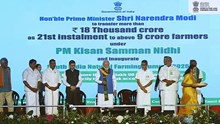
Agriculture is silently fuelling a global air pollution crisis that is harming both people and the planet, according to a new report titled "Agriculture – Sectoral Solutions for Air Pollution and Health: Technical Brief (2025)” released by the World Health Organization (WHO) on July 17, 2025.
Often overshadowed by emissions from energy and transport sectors, agricultural practices are a significant contributor to air pollution and climate change, particularly through the release of ammonia, methane, and fine particulate matter. These pollutants not only deteriorate air quality but also have devastating effects on human health, ecosystems, and crop yields.
Ammonia emissions from manure and synthetic fertilizers are a major concern. They react in the atmosphere to form fine particulate matter (PM2.5), which can penetrate deep into the lungs and bloodstream, increasing the risk of respiratory and cardiovascular diseases.
In Europe, agriculture contributes 94% of ammonia and 56% of methane emissions. These pollutants are responsible for tens of thousands of premature deaths each year. A 50% cut in agricultural emissions could prevent over 200,000 deaths annually worldwide, with massive economic benefits.
Crop residue burning, particularly common in South Asia, further worsens air quality, leading to seasonal smog and spikes in respiratory illness. In India alone, stubble burning is linked to an estimated 68,000 premature deaths every year. The practice persists despite bans and public awareness efforts, driven by the lack of alternatives and limited support for farmers to adopt sustainable methods.
The health toll is staggering. Exposure to air pollution from agricultural sources has been linked to a wide range of health problems, including acute respiratory infections, eye irritation, stress, and even mood alterations. Vulnerable groups such as children and the elderly are especially affected.
In the United States, food production alone accounts for nearly 16,000 annual air quality-related deaths. Globally, agriculture-related air pollution is estimated to cause over 500,000 premature deaths due to PM2.5 exposure and another 184,000 due to methane-induced ground-level ozone.
Beyond health, air pollution from agriculture also damages crops and ecosystems. Pollutants like nitrogen dioxide, ozone, and sulfur dioxide reduce crop yields and threaten food security. Studies show that reducing air pollutants can boost crop yields significantly, up to 28% for winter crops in China and nearly 10% in Europe. In the U.S., air quality improvements since 1999 have contributed to about 20% of overall crop yield gains.
Livestock farming is another major emitter, especially through methane from ruminants and nitrogen from manure. Poor manure and fertilizer management lead to nutrient loss, groundwater contamination, and emissions of greenhouse gases and air pollutants.
Transitioning to sustainable practices, such as better manure management and reduced use of synthetic fertilizers, is crucial. So too is the promotion of plant-based diets, which could reduce agricultural emissions and prevent up to 83% of related deaths in the United States.
Some regions have shown that progress is possible. In São Paulo, Brazil, legislation combined with private sector action has nearly eliminated the pre-harvest burning of sugarcane, reducing pollution and improving public health. The area harvested without burning rose from 34% in 2006 to 99% by 2022, avoiding over 70 million tonnes of atmospheric pollutants.
International efforts are growing. WHO and FAO are developing global assessments on nitrous oxide and methane emissions from agrifood systems. At the policy level, governments are being urged to improve rural air quality monitoring, implement no-burn alternatives, and integrate clean agriculture into national air quality and climate policies.
Experts emphasize that agricultural air pollution is not just a rural issue, it has far-reaching effects on urban populations, food systems, and economies. A "One Health" approach that links the health of people, animals, and ecosystems is vital. More research, better data collection, and greater intersectoral collaboration between agriculture, health, and environment ministries are needed.
















